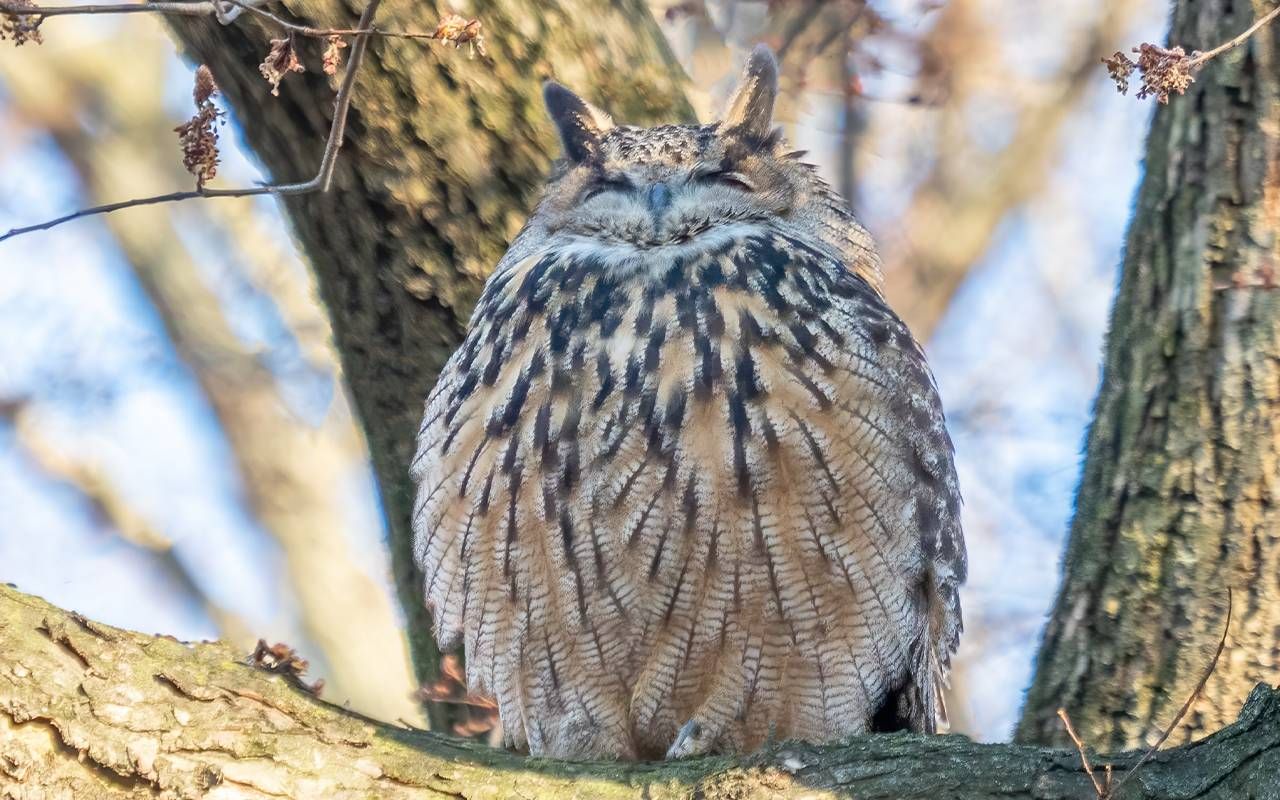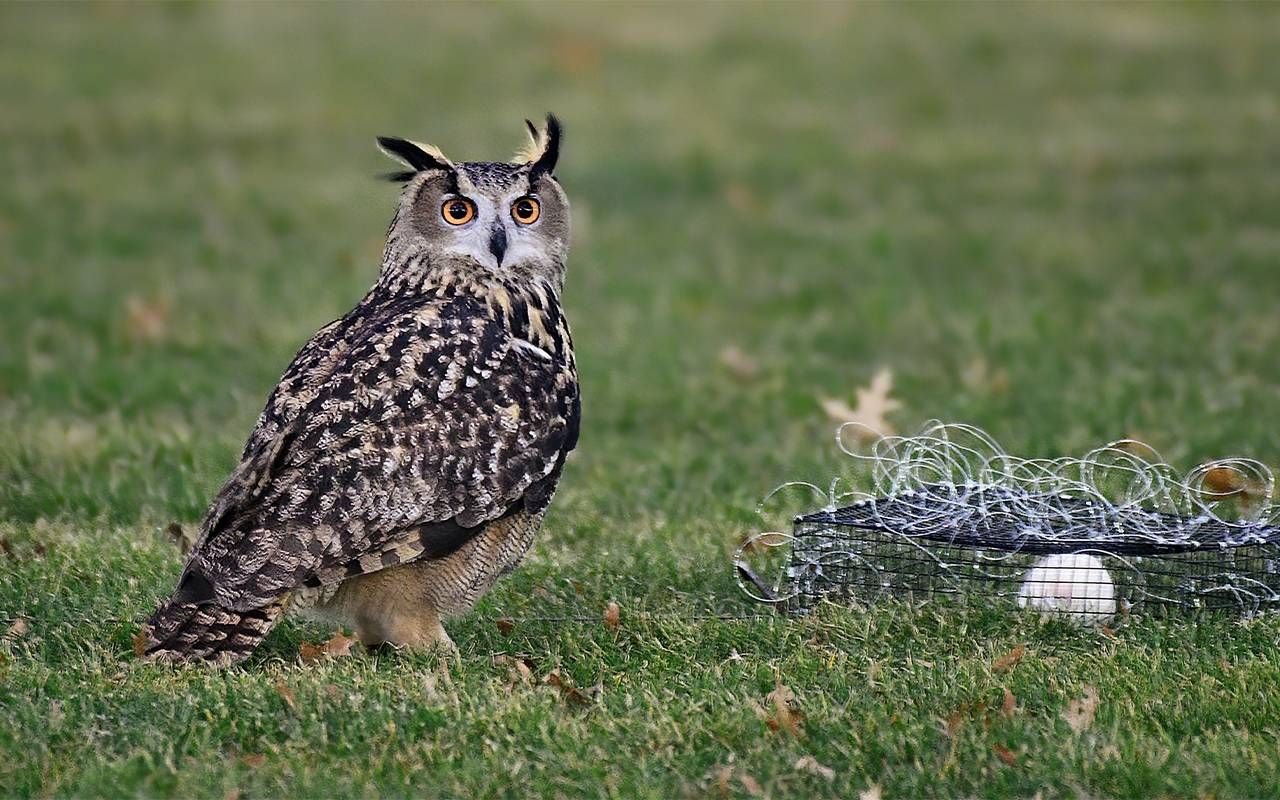Spreading Wings of Love for Flaco
Flaco was the perfect ambassador for New York City — a nocturnal soul living freely in the city that never sleeps. He touched my heart when I'd visit him in one of 'his' trees in Central Park.
Flaco, the Eurasian eagle owl, escaped the Central Park Zoo when a vandal apparently cut a hole in his steel mesh cage in February 2023; he went on to live freely for a full year, soaring high in New York City. He had been at the zoo for 12 years, his entire life.

Flaco passed away on February 23 of this year on the Upper West Side — the neighborhood where he'd been seen and heard hooting on top of water towers and apartment balconies in recent months. He was discovered lying injured in an apartment building courtyard. Rescuers from the Wild Bird Fund, located just blocks away, quickly attended to him but Flaco didn't make it.
"It's been an emotional experience for everyone at the clinic."
"It's been an emotional experience for everyone at the clinic," says Catherine Quayle, communications director of the Wild Bird Fund.
The cause of Flaco's exact death is still pending. "The Wildlife Conservation Society is performing the necropsy, and we don't know how long the results will take," says Quayle.
Flaco captured the hearts of so many people around the world — and continues to do so.
Flaco also deeply touched my heart. I'd visited him often at one of "his" trees, beginning when he was scouting Central Park soon after his escape. My favorite spot to visit Flaco was when he'd begun to hang out in a tree near the waterfall in Central Park's North Woods.
"The odds were against Flaco," says Quayle. "In his many years in captivity, Flaco had never flown or hunted, and was loose in a city of glass walls, cars and other raptors with far more street smarts. He didn't eat anything for almost two weeks, and then one day he caught a rat. The joy and relief among the Flaco watchers was immense. Flaco knew how to hunt."
From then on, the owl seemed to thrive, says Quayle. "He found his niche, and he made his unusual situation work for a whole year. This is a story that all New Yorkers and, really, people everywhere, can relate to. It's inspiring."
And she adds, "He was also an extremely handsome fellow. The camera loved him."
Why Flaco Was So Loved
A beloved pet is a family member and a best friend. When they pass away, the grief can be profound.
I was one of them who would visit when I needed a Flaco fix. And I always left feeling lighter and better after an encounter with this sweet soulful owl.
In many ways, although he was living in the wild, Flaco had become everyone's favorite pet. He was a best friend and a buddy and it felt like he had your back unconditionally. Flaco had visitors coming to him on days when they needed a Flaco wink or stare with those piercing golden eyes or a cute shake of his tufted ears.
I know this, because I was one of them who would visit when I needed a Flaco fix. And I always left feeling lighter and better after an encounter with this sweet soulful owl. He just made life better.
And at night, especially in recent months when Flaco had taken up residency on Upper West Side apartment balconies and water towers, it was comforting and exciting for neighbors to hear him hoot. He also enthralled and surprised unsuspecting residents with a peek inside their window. He was clever and fun.
For the most part during his Manhattan life, post zoo, Flaco made the trees in Central Park his home, especially fond of a couple that he'd return to nightly after his fly out — with his enormous six-foot wingspan like a New York Knicks player — to hunt for rats (and there was certainly no supply issues.)
"When I last saw him a week before his death, he looked as healthy and strong as ever, hooting from atop his favorite water tower and buildings on 86th Street."
Flaco's daily whereabouts were documented on X (formerly known as Twitter) by those who had spotted him on a morning run or on their way to work and by David Barrett, owner of popular Manhattan Bird Alert, who had amassed a huge following, thanks to his daily tweets about Flaco's hoots, or which tree Flaco was in that day, and smart insight into Flaco's behavior, like an owl whisperer.
"I am alright, but missing the beautiful creature whom I visited nearly every day when he was free in Central Park and with whom I often connected at night during his months on the Upper West Side," says Barrett. "When I last saw him a week before his death, he looked as healthy and strong as ever, hooting from atop his favorite water tower and buildings on 86th Street."
Flaco's story is one of triumph against the odds, says Barrett. "He amazed everyone by quickly adapting to life in the wild, learning to hunt and to fly skillfully. By thriving as a free owl after twelve years in a tiny enclosure, Flaco came to symbolize freedom and resilience."

Barrett says there are several Flaco memories that will make him smile in the days and years to come. "Flaco's curiosity about the world around him was charming," says Barrett. "He typically chose daily resting places in Central Park that allowed him to view human activity. He was comfortable with quiet people nearby, enough so to show us his owl behaviors: stretching, scratching, preening, hooting and sleeping. He took us on adventures in Central Park, and then when he wanted to explore new territory, across all Manhattan. He made the most of his year of freedom."
Remembering Flaco
There is a memorial for Flaco in Central Park beneath one of his favorite oak trees at East Drive and 104th Street — hundreds of flowers and notes and artwork and photos hug the tree. And the outpouring of love on social media has been staggering and continues.
"By thriving as a free owl after twelve years in a tiny enclosure, Flaco came to symbolize freedom and resilience."
There are also efforts to erect a permanent statue in Central Park. Thousands have already signed a petition. "I think the ultimate goal is to have a sufficient number of signatures to encourage the New York City Council to recommend commissioning a Flaco statue," says Barrett.
And the Wild Bird Fund has been receiving donations from all over the country, and overseas, following Flaco's death. "We're truly touched by this outpouring of generosity. It will help many other birds who've fallen on hard times in the city," says Quayle.
Also, a Central Park memorial service was scheduled for Sunday, March 3 in the afternoon at Flaco's oak tree.
Spring Migration
It's spring migration time soon, a challenging time for birds who try to navigate through the city.
"The city's lights are a beacon, drawing large numbers of migrating birds into the streets and parks," says Quayle. "Although we have lots of rich habitat for these visitors, much of this habitat is surrounded by walls of glass, which birds can't see or understand. They only see the sky or the trees reflected in the glass. This is why there are so many collisions here."
But, she says, it's important to note that this is not a skyscraper problem. "Most collisions occur at or below the treeline," says Quayle. "If the skyscrapers contribute, it's because of the bright light they emit, attracting birds to hazardous areas. Many of the newer skyscrapers also have floor-to-ceiling windows at the treeline. This is a deadly combination. Reducing the lights at night, and marking those lower-level windows to make them visible to birds, would greatly reduce window collisions."

Quayle says the Wild Bird Fund would like to see many more building owners take the initiative to make the necessary critical changes.
"The other component is light," says Quayle. "We need a solid lights-out program that will substantially reduce nighttime light during spring and fall migration. A bill addressing this issue will be reintroduced in the city council this year, and we hope to see it succeed."
And Flaco will continue to affect change. There is a bill being renamed for Flaco to address the building and window collisions.
Note: It is not believed that Flaco died from a building collision. The thinking is that he died from poison, and most likely falling off a railing as a result of being ill.
Birthday Boy
Flaco would have turned 14 on March 15 this year (he was born in North Carolina and then brought to the Central Park Zoo when he was months old.) Surely, there will be a birthday tribute in Central Park. As much love and comfort as Flaco brought to so many, I hope he knew how loved he was and that he will always be celebrated. He is really missed.


